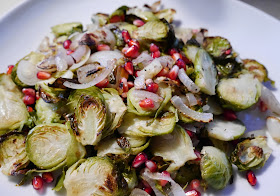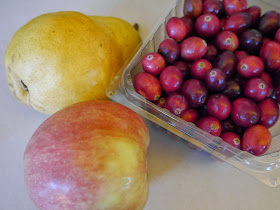 |
| Kale salad - a great way to include raw food in your winter diet. A single serving provides over 125% of your daily requirement of vitamin C. Follow Foods For Long Life on Facebook and Pinterest. |
Don't Forget About Raw Food
When it's hot out, it's fairly simple to eat most of our food raw - raw salads, chilled soups - even raw crisps. And although we crave cooked foods when the temperature drops, like soups, roasted veggies, and baked breads, we should still consume a minimum of at least thirty percent of our food raw. Raw fruit or green salads can easily do the trick.
For details on my Seasonally Raw Food Plan that explains the optimal balance of cooked to raw foods throughout the year, including recipes and menus, download my eBook, Health Begins in the Kitchen - available on iTunes and Amazon.
A Simple and Colorful Holiday Side Dish
This simple salad makes a lovely holiday side dish and it keeps really well. So if you are looking for something fresh and colorful for your Thanksgiving, Chanukah, or Christmas menu, this could be it!
* * *
Kale and Orange Salad with Pumpkin Seeds
Raw Vegan (Suitable for a Raw Food Cleanse)
[makes 6 servings]
For the dressing
4 teaspoons freshly squeezed lemon juice
4 teaspoons cold-pressed hemp or extra virgin olive oil (or combo)
1/2 teaspoon salt, or to taste
For the salad
4 packed cups stemmed, thinly sliced raw kale
2 oranges, peeled, seeds removed and chopped
1/4 red onion, thinly sliced
1/4 cup raw pumpkin seeds
Make the dressing by combining the lemon juice, oil, and salt directly in a large salad bowl.
Place the kale in the bowl and mix until each leaf is well coated. Let the kale sit in the dressing to allow it to tenderize, about 15 to 20 minutes.
Add the oranges, red onion, and pumpkin seeds. Toss well and serve.
Per serving (with hemp oil): 104 calories, 6 g total fat, 1 g saturated fat, 539 mg omega-3 and 3,039 mg omega-6 fatty acids, 0 mg cholesterol, 3 g protein, 12 g carbohydrates, 2 g dietary fiber, and 381 mg sodium.
Per serving (with olive oil): 104 calories, 6 g total fat, 1 g saturated fat, 117 mg omega-3 and 1,554 mg omega-6 fatty acids, 0 mg cholesterol, 3 g protein, 12 g carbohydrates, 2 g dietary fiber, and 381 mg sodium.




















